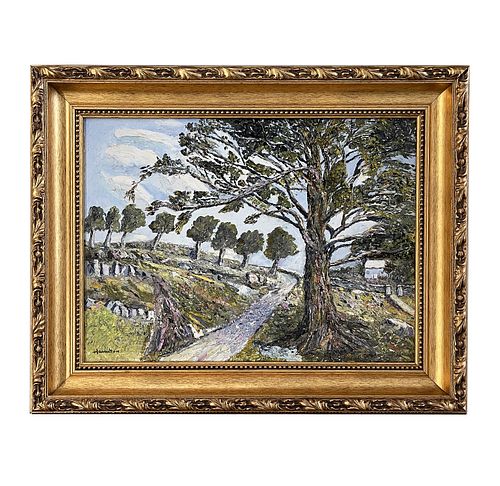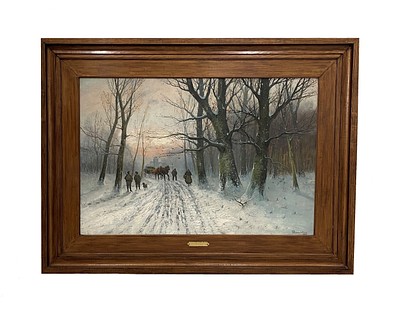Helen Hamilton (1889 - 1970) American
Lot 14
About Seller
Coral Gables Auction LLC
2377 Coral Way
Coral Gables, FL 33145
United States
We are an auction house with a lot of knowledge of our work environment. We recited at Miami FL. We have professionals with more than 30 years of experience. We work hard to provide our subscribers with the best descriptions of the auctioned pieces and their provenance, in addition to providing good...Read more
Estimate:
$2,000 - $3,000
Absentee vs Live bid
Two ways to bid:
- Leave a max absentee bid and the platform will bid on your behalf up to your maximum bid during the live auction.
- Bid live during the auction and your bids will be submitted real-time to the auctioneer.
Bid Increments
| Price | Bid Increment |
|---|---|
| $0 | $25 |
| $500 | $50 |
| $1,000 | $100 |
| $3,000 | $250 |
| $10,000 | $500 |
| $20,000 | $1,000 |
| $50,000 | $2,500 |
| $100,000 | $5,000 |
| $200,000 | $10,000 |
| $500,000 | $25,000 |
About Auction
By Coral Gables Auction LLC
May 15, 2022
Set Reminder
2022-05-15 14:00:00
2022-05-15 14:00:00
America/New_York
Bidsquare
Bidsquare : Fine & Decorative Arts Online Auction #027
https://www.bidsquare.com/auctions/coral-gables-auction-llc/fine-decorative-arts-online-auction-027-9330
This auction has 100 pieces. There is a great variety of paintings Coral Gables Auction LLC coralgablesauction@yahoo.com
This auction has 100 pieces. There is a great variety of paintings Coral Gables Auction LLC coralgablesauction@yahoo.com
- Lot Description
Helen Hamilton (1889 - 1970) American
Oil on Board
Measure 18"in H x 24"in W and 24 3/4"in H x 31"in W with frame
Known for: Landscape, seascape-marine paintings
Biography: Helen Hamilton was the daughter of painter Hamilton Hamilton (1846-1928). She was born with her twin sister Margaret in June of 1889, shortly after her father had been elected to full membership at the National Academy of Design. Helen showed artistic talent at an early age. At around the age of nineteen, she moved with her family to Pasadena, California. She received on-the-spot training from her father in the Sierra Madre Mountains and was initiated to impressionism. By 1910 the family was living in New York, where Helen enrolled at the National Academy. The Hamiltons also had a house in Silvermine, Connecticut on Buttery Road, near the home of D. Putnam Brinley, a leading spirit of the Silvermine artists' colony. By 1912, Helen was taking part in the Silvermine group exhibitions. Her works from this period have all of the characteristics of impressionism: a high-keyed palette, blue and purple shadows, and juxtaposed strokes of contrasting color. Helen knew the latest art trends and personalities by exhibiting with her father and by being exposed to the activities of the Association of American Painters and Sculptors, the group of artists who sponsored the famous 1913 Armory Show. Although neither Hamilton nor his daughter exhibited there, works by Silvermine artists were on view among the sensational works of Duchamp, Brancusi, and Archipenko. It is here that Helen probably discovered Van Gogh, since fourteen of his canvases were on display: the modern Dutch master would become Hamilton's major source of inspiration. During the years of the first world war, Hamilton developed a modernist style in which form was designed with color and subject matter was secondary. For Richard H. Love (1986, p. 28), Helen Hamilton produced an oeuvre that was "more advanced in form and color than that of other Americans who attempted to find new alternatives to impressionism." Perhaps to counteract her small stature and shy personality, Hamilton attacked the canvas boldly with a palette knife, using energetic forms, bright colors, and thick pigment. Like Giulia Lama, who produced colossal, painterly murals in eighteenth-century Venice, Helen Hamilton serves as an example to refute those who still maintain that works of art by women are characteristically small, overly fussy or linear, and sentimental, decorative, or otherwise unimpressive. After her father's death in 1928, Helen received continuously favorable comments from critics. In the 1930s, Hamilton's modernist watercolors are comparable to those of John Marin, for both artists "described shapes and space with an enigmatic mix of colorful arabesques and hard, angular passages, flat reflective surfaces, and deeply opaque patterns, all in all a subjective interpretation of the ever changing volumes of nature" (Love, 1986, p. 45). Hamilton's subsequent powerfully expressive canvases, executed with a palette knife, belong to the history of post-impressionism.Important Message Regarding Payments : All invoices that exceed the amount of $ 2000 including the buyer premium, must make the payment through check or wire transfer, if we receive the payment through the platform, the money will be reimbursed automatically to your cardCondition
Coral Gables Auction strongly encourages in-person inspection of items by the bidder
Statements by Coral Gables Auction regarding the condition of objects are for guidance only And should Not be relied upon as statements of fact, and do Not constitute a representation, warranty, Or assumption of liability by Coral Gables Auction
All lots offered are sold "As Is"
For condition report please contact our auction house via email info.coralgablesauction@yahoo.com - Shipping Info
-
For Shipping Information Please send Email to info.coralgablesauction@yahoo.com
-
- Buyer's Premium



 EUR
EUR CAD
CAD AUD
AUD GBP
GBP MXN
MXN HKD
HKD CNY
CNY MYR
MYR SEK
SEK SGD
SGD CHF
CHF THB
THB







